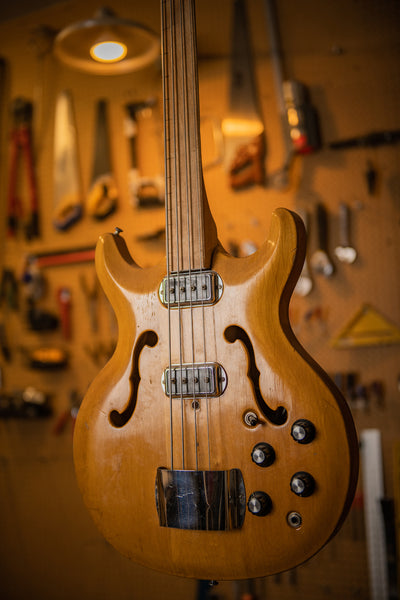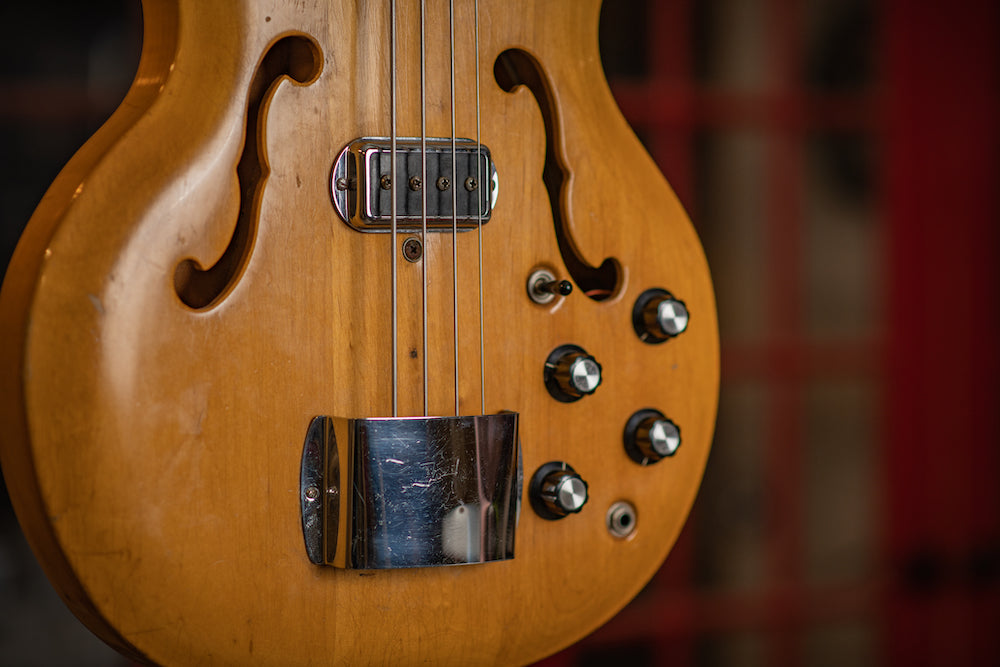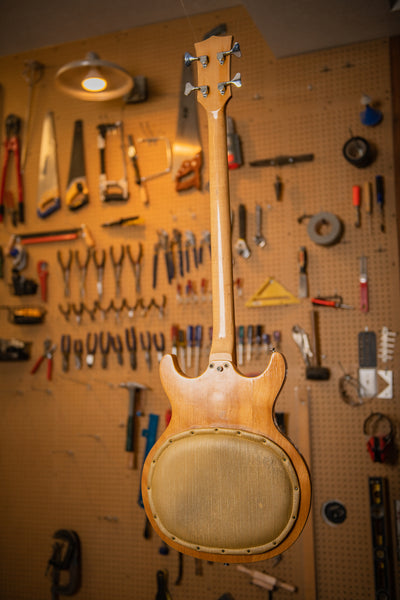Meet the Bartell Bass
Posted by Eben Cole on
Here’s the story of how I came to own the first commercially produced fretless bass. No really!
A little back story...
For the most part, growing up in Spokane WA was pretty typical. We rode skateboards, climbed trees, threw dirt clods at each other. Monsters of Rock came to town one year, that was a big deal. I was extremely fortunate to have a great childhood (even though I didn’t get to go to Monsters of Rock.) My family was as middle of the sociological road as you could get; caucasian, middle class, two parents, two kids and one dog (a Golden Retriever, just to seal the stereotype).
While my home life may have mirrored a 90’s sitcom, there was one way my life was very different from most kids. My father was a high ranking member of the Illuminati—Ok, maybe not, but he was an expert in fine instruments, and in the day before the insta-knowledge of the internet, that seemed like a mystical power. I remember coming home from high school one day, and my father and another guy were in our living room, holding and discussing a violin, that just happened to be a real Antonio Stradivari. I recall another time my dad came home with four tobacco burst pre-CBS Strats he found through the local want ads. When I wanted to take guitar lessons in the 9th grade, he found a 1974ish Les Paul Custom for me to rock some “Fly By Night” on. I remember my guitar teacher telling me what an incredible guitar it was, and I told him it was “ok, but my buddy had a brand new Kramer that was bad ass!”
Unfortunately, I didn’t really appreciate all the cool stuff I got to handle in my youth. I didn’t understand what these things represented, their historical value, or even just the roles they played in the music I listened to.
Years later though, when I found myself owning and operating a guitar store, it became the vintage gear that really spoke to me. Aside from the fact that classic guitars trade like commodities, there is an intrinsic familiarity there for me. There is also a sense of evolution. Through years of handling my share of amazing vintage pieces I get to see, and feel, how guitars morph over time.
What really intrigues me these days are the unknowns. Don’t get me wrong, my heart still races every time I handle a 1950’s Tele or a pre-war Martin. But what really captures my interest are the pieces that are off the radar to the masses. There is enough info out there on verifying vintage instruments that what used to be privy to only those who put in the research, like my father did, is now accessible to anyone with a smartphone.
So when something wanders into the store that I haven’t seen before, that always piques my interest.
My friend Derrick is also a glutton for odd guitars. He came in one day with an unbranded hollowbody bass he had bought off of Craigslist, claiming it was the first fretless bass guitar ever produced for the mass market. Since I am a self proclaimed expert on vintage guitars (aka a know it all dick), I informed him that Ampeg made the first fretless bass. Duh! But, Derrick had already done his research, and had placed it as some sort of relative of the famed “Acoustic Black Widow” bass even before he bought it off the original owner. What he was most surprised to find was that it may be the first of the first fretless bass guitars!

THE FIRST FRETLESS BASS?
Despite what Jaco Pastorius claimed, his many contributions to the bass world do not include the invention of the fretless bass. The first fretless electric bass can be credited to Paul Tutmarc of Seattle around 1935. Though technically his fretless was a short scale, amplified upright design and not a true bass guitar. A few years later, in 1938, Gibson would produce a couple fretless electric basses, but again they were 42⅜” upright scale length. Ampeg is often credited with the first production “Electric Fretless Bass Guitar” in 1966, but Paul Barth actually beat them to market in 1965 with his Bartell branded fretless bass (BTW, this is not the last that we hear of Tutmarc or Barth, join our email list to get our “First Humbucker” story, it'll knock your socks off!).
PAUL BARTH AND THE BARTELL BASS
Paul Barth had a fairly extensive history in the guitar world, though very few will know his name. He was one of “those guys” that may not be well known, but has had his influence on the evolution of guitardom. That is not uncommon when you really dig down into the less glamorous stories of guitar history. But it is all relevant, and often these guy’s designs are what paved the way for those iconic instruments we all know and lust after. Paul Barth was one of those individuals.
Paul made his name working for John Dopyera in NYC. We’re talking pre National String Instrument Corporation here. From 1928 to 1934 Barth helped establish National Guitars which eventually became/merged with Rickenbacker. During his early years with Rickenbacker he worked closely with George Beauchamp, whom helped bring the electric guitar into the world via the infamous Rickenbacker “Frying Pan”. All of this was made possible by a revolutionary pickup designed by a woefully unknown inventor named Art Stimson (again, subscribe to get this story, which is coming soon… and it is spectacular!). Barth rose through the ranks to eventually become the Chief Designer for the Rickenbacker Corporation in the 50’s.
In 1960 Barth left the mayhem of the National/Rickenbacker/RO-PAT-IN/Dobro family fiasco for a fresh start at Magna Electronics Company designing Magnatone guitars, a job previously held by Paul Bigsby—something I never knew about Bigsby. (If anyone out there has a Bigsby designed Magnatone, hit me up!)
Eventually Paul Barth decided to pave his own path and started Bartell Inc. in Riverside CA in the early 1960’s. Bartell manufactured, in rather low numbers, tube amps, guitars, and even a few effects pedals; but they were best known for their fretless basses, and the first electric fretless bass guitar at that. Barth made instruments under a variety of names including Bartell, Lancer, Contessa, St.George, and Acoustic “Black Widow”, but the majority seem to be produced under the Hohner name.

CONSTRUCTION
One of the most noticeable traits of this bass is the partial fret markers. It appears as if the fret lines were made by partially sawing fret slots into the bass side of the maple fingerboard. Judging by how thin the maple cap is, the uneven length of the lines and the placement of the side dots, the fingerboard was partially ran through a fret slotting jig and then sanded very thin after being glued to the neck. The maple neck has remarkably thin profile compared to other instruments of the era. The bolt on neck also features a unique long tenon/tongue that extends half way through the body, with an adjustment screw located under the bridge pickup for adjusting the neck angle. It's a pretty clever design.
The 1¾” deep, “F” Hole semi-hollow body was made from 3 pieces of maple and hollowed out from the back side. A flat maple cap makes up the back of the bass, with a Gretsch-esque padded back cover. The pots are original, yet have no discernable date code to them. Paul was known for his hand wound pickups, and these single coils sound amazing.

CONCLUSION
I figured Derrick’s claim that his bass was probably the earliest known example of the first fretless electric bass had merit, but when I had the fortune to buy the bass from him I figured I would investigate for myself. Occasionally a Bartell/Hohner/Acoustic may pop up, and usually with quite a bit of misinformation ascribed, which is understandable given the lack of resources. After exhaustive research I found the best information to be from former Bartell employee Doug Donaghue, via the website Bartell Guitars and Basses. This is the best resource on Bartell guitars, and Donaghue did the majority of the assembly in the first years of production. So here are the facts Jack:
- No branding/logos. Indicates early prototype production before Bartell and Hohner branding.
- Donaghue states “I don't remember where the serial numbers on any of those guitars began, but it might well have been at 91190. (Or even 91191.)” This bass in question is #91164
- Donaghue also states that he handled the majority of the assembly, with the exception of the first few. These early pieces had masking tape on the wiring harnesses, and then switched to electrical tape. This example has masking tape.
- On all other examples the four control knobs descend towards the bridge, on this example they ascend—like a Les Paul.
- From what I have seen in pictures of other Bartell Basses, the fret markers seem to be much more erratic in length on this one. As if they still hadn’t figured how to consistently saw the fret markers.
Is this one of the first, or perhaps the very first Bartell Bass? Who knows. Unfortunately, there probably isn’t any new info on the Bartell Company that is going to surface soon, or ever for that matter. As is common with guitar makers of that era, they may have been making a great product, but 50 years later, unless someone with notoriety gives an “off brand” attention (re. Jack White, Dan Auerbach etc.) they remain in the hands of those who appreciate that it is not a big brand name. Iconic designs are ubiquitous, but playing something no one else has—that's pretty cool. You know what else is cool? Ash Madison tearing it up on a Bartell Bass. Give it a listen.
- Tags: News
← Older Post Newer Post →
I’m glad to have found this page. The only guitar I regret selling is a Bartell XK-150. The body was poplar and the neck was rock maple from Canada. It’s very similar in construction to the Magnatone Starstream series.
Hi, can anyone tell me what is the wood used on the Bartell fingerboard 6 string guitar. It looks like ebony with rosewood underneath a maple neck, some say it was a black epoxy but it looks very thick. Also what was the body made from. The Lennon /Harrison fretless guitar appeared on a TV show in the UK two weeks ago, It had a compensating bridge on this guitar. many thanks.
Steve.
Hi, can anyone tell me what is the wood used on the Bartell fingerboard 6 string guitar. It looks like ebony with rosewood underneath a maple neck, some say it was a black epoxy but it looks very thick. Also what was the body made from. The Lennon /Harrison fretless guitar appeared on a TV show in the UK two weeks ago, It had a compensating bridge on this guitar. many thanks.
Steve.
I have a non-branded model with maple neck and sunburst paint. Love it to death!
Hey Paul, I do not have any info on the 6 string guitars, primarily because I was focused on researching the basses. Shoot me an email through the website contact form and I will see if I can help. Thanks! Eben